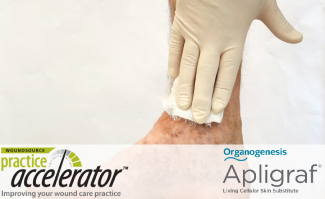Understanding Venous Leg Ulcers and Infection
August 31, 2021
Introduction
Of all the types of chronic wounds in lower extremities, venous leg ulcers are the most common, and they account for up to 70% of lower leg ulcers.1 Infection is a common complication in these wounds, however, and may contribute to chronicity.2 Biofilm is another common complicating factor. Preventing infection, removing unhealthy tissue from the wound, providing dressings that manage exudate, and using advanced modalities can help heal these chronic wound types and prevent a recurrence.
Infection Prevention Challenges and Strategies
Preventing infection in venous leg ulcers can be challenging. This wound type is often stuck in the inflammatory phase of wound healing. Reaching for wound cleansers that penetrate biofilm, such as hypochlorous acid, cleansers with polyhexamethylene biguanide, and cleansers with surfactants can make a difference. Look for a cleanser with a biofilm indication to determine whether that cleanser can help heal these difficult-to-treat wounds.
Venous leg ulcers can commonly manifest with slough. Removing non-viable or desiccated tissue helps allow healthy tissue to grow. Slough in this common wound type can be treated with various forms of debridement. Mechanical debridement can be performed while cleansing the wound bed. If slough is still adherent, clinicians trained in sharp debridement, when covered under their scope of practice, can accelerate wound healing while managing biofilm. Obtaining a prescription for enzymatic debridement for topical use and applying this agent to the wound can also remove biofilm and knock the wound out of the inflammatory phase into the healing phase. Choosing a dressing to assist with autolytic debridement can also help the wound heal. Dressings and moisture management are top priorities with venous leg ulcers. Venous leg ulcers are commonly known to have moderate to heavy drainage. Although managing drainage in and of itself usually does not cure a venous leg ulcer, it is still essential to prevent periwound maceration. Reach for dressings that can stay under compression for several days or up to a week at a time. Dressings that wick moisture away from the wound bed while encouraging moist wound healing are ideal. Consider calcium alginates, foam dressings, or negative pressure wound therapy to manage heavy exudate. Other advanced modalities include compression wraps. Compression should be implemented only once studies have confirmed that the patient’s arterial status can tolerate compression without interrupting blood flow or creating blood clots. Arterial blood flow is typically confirmed through arterial studies such as ankle brachia index measurements, arterial ultrasound scans, and even arteriograms. Underlying venous disease can be confirmed through venous ultrasound scans or venograms to determine the extent of the disease. If the venous wound has a history of recurrence, consider sending the patient to a vascular surgeon to assess for the presence of perforators. If a perforator is causing a recurrent ulcer, a vascular surgeon can perform a minimally invasive procedure to ablate the perforator and remove the underlying cause of the wound. Types of compression vary, as does the strength of compression needed and applied. Knowing the underlying arterial status allows the clinician to determine the amount of compression required to treat the venous ulcer while avoiding damage to the arterial blood flow. The ambulatory status of the patient is also essential information when determining the type of compression required. Some forms of compression bandages or stockings work with the calf muscle when the patient ambulates. Other forms of compression do not need the calf muscle to flex when working. The skin is the first defense against infection. Any open wound provides an opportunity for bacteria, fungi, viruses, and other pathogens to enter the body and compromise the immune system. Encouraging rapid closure of open wounds can help to prevent infection. The use of cellular and/or tissue-based products can encourage closure of wounds such as venous leg ulcers. These products provide scaffolds for new tissue to build on. Some products have living cells to help the process further. Patient compliance and education are also paramount. If a patient is obese and can lose weight, this will positively impact the venous leg ulcer. If the patient smokes and can participate in a smoking cessation program, the added oxygen to the lower extremity will help heal the ulcer. Another factor to consider to prevent recurrence is adherence to lifelong compression garment use, whether with stockings or lymphedema pumps, when medically necessary and prescribed.
Conclusion
Venous leg ulcers can commonly have an arterial component, so ensuring accurate diagnosis of the underlying pathophysiology and disease process is critical to understanding which therapeutic modality or wound healing principle will work best for the patient. Venous ulcers can take weeks to months and even years to heal. Intervening early, preventing infection, choosing adequate debridement strategies, and managing drainage with appropriate dressings while using an interdisciplinary approach create an optimal healing environment to give your patient the best advantage in wound healing.
References
- Pugliese DJ. Infection in venous leg ulcers: considerations for optimal management in the elderly. Drugs Aging. 2016;33(2):87-96. doi: 10.1007/s40266-016-0343-8. PMID: 26833351.
- O’Donnell TF Jr, Passman MA, Marston WA, et al. Management of venous leg ulcers: clinical practice guidelines of the Society for Vascular Surgery and the American Venous Forum. J Vasc Surg. 2014;60(2):3S–59S.
The views and opinions expressed in this blog are solely those of the author, and do not represent the views of WoundSource, HMP Global, its affiliates, or subsidiary companies.
The views and opinions expressed in this content are solely those of the contributor, and do not represent the views of WoundSource, HMP Global, its affiliates, or subsidiary companies.







